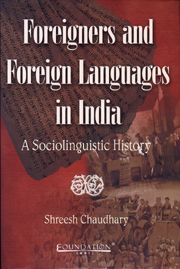Book contents
- Frontmatter
- Contents
- List of Annexes
- Notation Used for Transcribing Non-English Words, Names, Etc.
- Foreword
- Preface
- Acknowledgements
- 1 Introduction
- 2 Greek, Hebrew and Sanskrit
- 3 Arabic, Persian and Turkish
- 4 Armenian, Portuguese, Dutch and French
- 5 East India Company and The Indian Languages
- 6 East India Company and The English Language
- 7 Conclusion
- Index
6 - East India Company and The English Language
Published online by Cambridge University Press: 26 October 2011
- Frontmatter
- Contents
- List of Annexes
- Notation Used for Transcribing Non-English Words, Names, Etc.
- Foreword
- Preface
- Acknowledgements
- 1 Introduction
- 2 Greek, Hebrew and Sanskrit
- 3 Arabic, Persian and Turkish
- 4 Armenian, Portuguese, Dutch and French
- 5 East India Company and The Indian Languages
- 6 East India Company and The English Language
- 7 Conclusion
- Index
Summary
‘What do you think of the English civilisation?’, a reporter once asked Gandhi.
‘It would be a good idea’, Gandhi said.
Introduction
As this remark attributed to Mohandas Karamchand Gandhi (ad 1869–1948) shows, most educated Indians use English in a variety of situations in nearly all domains today, yet few of them treat it as their native or their ‘own’ language. How did this situation come about? In spite of centuries, let alone numbers, even the percentage of people speaking Persian, Portuguese or Sanskrit never came close to the percentage of Indians using English today in spite of the fact that English has been in public domain in India for fewer than 300 years. There are, relatively speaking, lots of Indians that write ‘standard’ English acceptable easily worldwide, but there are relatively few who speak this language that way. Actually, the English generally spoken in India has become a different language from, and is no longer a variety of, the ones spoken in the UK, the USA, etc. How did this happen? Was English imposed upon India? Was this accomplished by the duo of T B Macaulay (ad 1800–1859) and William Bentinck (ad 1774–1839), as many people believe? Did Indians not want it at all? These and many other questions arise in the context of the sociolinguistics of English in India. Here we will try to answer some of them.
- Type
- Chapter
- Information
- Foreigners and Foreign Languages in IndiaA Sociolinguistic History, pp. 392 - 516Publisher: Foundation BooksPrint publication year: 2008



